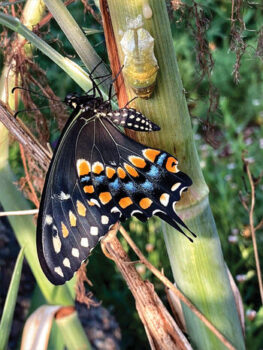
Black Swallowtail with an empty cocoon (Photo by Angie Lindsey)
Janet Laminack, County Extension Agent-Horticulture, Texas A&M AgriLife Extension—Denton County
In order to make seeds, plants need to be pollinated. Some plants are self-pollinated, but many rely on some other creature, a pollinator, to assist in the process. We tend to think of honey bees and butterflies, but native bees, flies, beetles, birds, and even mammals like bats can be pollinators.
The most glamorous of pollinators are probably butterflies. Flitting around just as lovely as the flowers they visit. Butterflies start life in a larval stage as a caterpillar. Believe it, those lovely, dainty creatures come from a vile worm-like plant-devouring tube. Actually, caterpillars can be quite attractive themselves. I think it helps to know that the caterpillar eating your plant will turn into a beautiful butterfly. It can be easy to identify what caterpillar you are dealing with by their distinct markings and by what plant you find them gnawing.
The gulf fritillary is a small orange butterfly that loves all kinds of flowers. But, the gulf fritillary as a caterpillar prefers passionflower and it’s hard to miss these spiky, menacing, orange caterpillars as they snack on the leaves of this vine.
Swallowtail butterflies are large and multi-colored. I commonly see black ones with blue and yellow spots or yellow winged ones with a touch of blue. As a caterpillar, the swallowtail is a stunning yellow, black, and white. A tasty menu for swallowtails includes parsley, fennel, dill, and rue. I plant these herbs specifically for the butterflies, making sure to get several plants in case the caterpillars are especially voracious. If you provoke a swallowtail caterpillar, you might see yellow horn-like things (osmeteria) protruding from the head as it rears up. As a defense mechanism, the stink of whatever it is that comes out of those things definitely deters me.
Of course, I must mention the monarch butterfly that inspires and awes with its transcontinental annual migration. Like everything else in this area, the monarch comes in on I-35 as it makes its way north or south. Seriously though, all of I-35 from Minnesota to Texas is called the “Monarch Highway.” Monarch butterflies feed on the nectar of native plants like lantana and goldenrod. But milkweeds are the only host plant and larval food source for the monarch caterpillar. There are different species of milkweed, so be sure to get species that are native to our area. Xerces.org has plant lists that can help.
You can make a difference in protecting pollinators. Research shows that small plantings can have big impacts on urban pollinators. Planting a diversity of flowering native plants ensures a steady nectar and source for all these fine creatures.
Texas A&M AgriLife Extension provides equal opportunities in its programs and employment to all persons, regardless of race, color, sex, religion, national origin, disability, age, genetic information, veteran status, sexual orientation, or gender identity. The Texas A&M University System, U.S. Department of Agriculture, and the County Commissioners Courts of Texas Cooperating.
